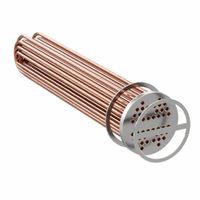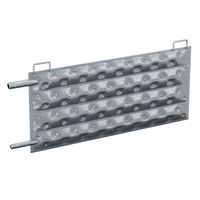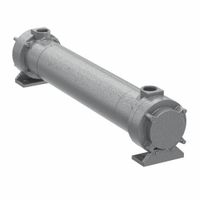Call +(254) 703 030 000 / 751 483 999 / 721 704 777
- Home
- Hvac And Refrigeration
- Heat Exchangers
.....Read More
Frequently Asked Questions
What is a heat exchanger and how does it work?
A heat exchanger is a device designed to efficiently transfer thermal energy between two or more fluids at different temperatures, without direct contact between them. This transfer occurs through a solid barrier that separates the fluids.
The fundamental principle behind a heat exchanger is the second law of thermodynamics, where heat naturally flows from a hotter medium to a cooler one. Heat exchangers are engineered to maximize this transfer by increasing the surface area for heat exchange and by creating turbulent flow within the fluids, which enhances mixing and heat transfer rates.
There are various types of heat exchangers, but they generally operate on similar principles:1. **Fluid Flow:** Two fluids, one hot and one cold, enter the heat exchanger.
2. **Separation:** These fluids flow in separate channels or pipes, preventing them from mixing.
3. **Heat Transfer:** Heat from the hotter fluid is transferred across the separating barrier (e.g., a metal plate or tube wall) to the colder fluid. This transfer can occur via conduction through the solid barrier and convection between the fluid and the barrier.
4. **Exiting Fluids:** The now-cooled hot fluid and the now-heated cold fluid exit the heat exchanger.Common configurations include shell-and-tube, plate, and finned-tube heat exchangers, each suited for different applications based on fluid properties, pressure, temperature, and space constraints. They are critical components in a wide range of industries, from HVAC systems and power generation to chemical processing and refrigeration.
What are the different types of heat exchangers?
Heat exchangers are devices that transfer heat between two or more fluids at different temperatures. They are widely used in various industries, including HVAC, refrigeration, power generation, and chemical processing. The different types of heat exchangers can be broadly categorized based on their construction and flow arrangement:
**Based on Construction:** * **Shell and Tube Heat Exchangers:** These are the most common type, consisting of a bundle of tubes inside a cylindrical shell. One fluid flows through the tubes, and the other flows over the tubes within the shell. They are robust and suitable for high-pressure and high-temperature applications.
* **Plate Heat Exchangers:** These are composed of a series of thin, corrugated plates pressed together. Fluids flow through alternating channels formed by the plates, providing a large surface area for efficient heat transfer. They are compact, easy to clean, and suitable for viscous fluids and temperature approaches.
* **Fin and Tube Heat Exchangers:** These typically consist of tubes with extended surfaces (fins) attached to increase the heat transfer area. They are commonly used in air conditioning and refrigeration systems where one fluid is a gas (like air) and the other is a liquid.
* **Double Pipe Heat Exchangers:** These are the simplest type, consisting of two concentric pipes. One fluid flows through the inner pipe, and the other flows through the annular space between the pipes. They are suitable for small flow rates and high-pressure applications.**Based on Flow Arrangement:** * **Parallel Flow:** Both fluids enter the heat exchanger at the same end and flow in the same direction.
* **Counter-Flow:** Fluids enter at opposite ends and flow in opposite directions, providing the most efficient heat transfer.
* **Cross-Flow:** One fluid flows perpendicular to the other. This arrangement is common in fin and tube heat exchangers.Other types include regenerative heat exchangers, compact heat exchangers, and spiral heat exchangers, each designed for specific applications and operating conditions. The choice of heat exchanger type depends on factors such as fluid properties, temperature and pressure requirements, space limitations, and cost.
How do shell and tube heat exchangers compare to plate heat exchangers?
Shell and tube heat exchangers and plate heat exchangers are two common types of heat transfer equipment, each with distinct advantages and disadvantages.
Shell and tube heat exchangers consist of a bundle of tubes inside a cylindrical shell. One fluid flows through the tubes, while the other fluid flows over the tubes within the shell. They are known for their robust design, high pressure and temperature capabilities, and suitability for handling dirty or corrosive fluids. They are also relatively easy to clean and maintain. However, they tend to be larger, heavier, and less thermally efficient than plate heat exchangers for certain applications.
Plate heat exchangers, on the other hand, are made of a series of thin, corrugated plates pressed together to form channels. The two fluids flow in alternating channels, allowing for efficient heat transfer across the large surface area of the plates. They are highly efficient, compact, and offer close temperature approaches, making them ideal for applications with tight space constraints and where high thermal performance is critical. They are also highly customizable in terms of capacity. However, they generally have lower pressure and temperature limits compared to shell and tube exchangers and may not be suitable for fluids with high particulate content due to potential clogging of the narrow channels.
The choice between the two depends on factors such as fluid properties, operating conditions (temperature, pressure), space availability, maintenance requirements, and cost.
What are the advantages and disadvantages of high-efficiency plate heat exchangers?
High-efficiency plate heat exchangers offer several advantages, making them a popular choice in various industries. Their primary benefit lies in their exceptional thermal efficiency, achieved through a large heat transfer area within a compact design. The corrugated plates create turbulent flow, enhancing heat transfer rates and allowing for closer temperature approaches between fluids. This efficiency translates to significant energy savings and reduced operating costs. They are also highly versatile, capable of handling a wide range of fluids and operating conditions, and their modular design allows for easy expansion or modification. Maintenance is generally simpler due to easy access to plates for cleaning, and the compact size requires less installation space.
However, these heat exchangers also have disadvantages. They are generally less suitable for fluids containing suspended solids or fibers, as these can clog the narrow plate gaps and reduce efficiency. The gaskets used between plates can be a source of leaks, especially under high pressure or temperature fluctuations, and may require regular replacement. The initial capital cost can be higher compared to shell-and-tube heat exchangers for some applications. Furthermore, the design can be complex for very high-pressure or high-temperature applications, and the pressure drop across the plates can be higher, requiring more pumping power for certain systems.
How do you maintain a heat exchanger?
Maintaining a heat exchanger is crucial for optimal performance and longevity. Key steps include regular cleaning to prevent fouling and scaling, which can reduce efficiency and increase pressure drop. This often involves chemical cleaning, mechanical brushing, or high-pressure water jetting, depending on the type of fouling.
Another critical aspect is leak detection and repair. Gasket integrity should be checked regularly, and any signs of leakage addressed promptly to prevent fluid loss and cross-contamination. Pressure testing can help identify leaks before they become major issues.
Monitoring operational parameters like temperature, pressure, and flow rates is also essential. Deviations from normal operating conditions can indicate problems such as fouling, blockages, or internal leaks, prompting further investigation.
Lastly, periodic inspections of the heat exchanger's physical condition, including external corrosion, support structures, and connections, are important for identifying potential mechanical failures or safety hazards. Adhering to the manufacturer's recommendations for maintenance schedules and procedures is always advised.
What are common applications of heat exchangers?
Heat exchangers are devices that transfer heat between two or more fluids at different temperatures. They are widely used in various industries and applications, playing a crucial role in energy efficiency and process optimization.
Common applications include: * **HVAC (Heating, Ventilation, and Air Conditioning) Systems:** Heat exchangers are integral to residential and commercial HVAC systems for heating and cooling buildings. They are found in furnaces, air conditioners, and heat pumps, facilitating the transfer of heat between refrigerants and air.
* **Refrigeration:** In refrigerators and freezers, heat exchangers (evaporators and condensers) are used to absorb heat from the cooled space and dissipate it into the surroundings, maintaining low temperatures.
* **Power Plants:** Heat exchangers are critical in power generation. In conventional thermal power plants, they are used in boilers to transfer heat from combustion gases to water, producing steam. In nuclear power plants, they transfer heat from the reactor coolant to a secondary fluid to generate steam.
* **Chemical and Petrochemical Industries:** These industries heavily rely on heat exchangers for various processes such as heating and cooling reactants, condensers for distillation, and reboilers for separation processes.
* **Automotive Industry:** Radiators in vehicles are a common example of heat exchangers, designed to cool the engine by transferring heat from the engine coolant to the ambient air.
* **Food and Beverage Processing:** Heat exchangers are used for pasteurization, sterilization, and cooling of food products, ensuring safety and quality.
* **Waste Heat Recovery:** They are employed to recover waste heat from industrial processes, which can then be reused for other purposes, improving energy efficiency and reducing environmental impact.
* **Oil and Gas Industry:** Heat exchangers are used in refineries for crude oil processing, gas liquefaction, and other operations requiring precise temperature control.The versatility of heat exchangers makes them essential components in a vast array of industrial and everyday applications, contributing significantly to energy conservation and process efficiency.
How do immersion heat exchangers work?
Immersion heat exchangers work by transferring heat between two fluids without them coming into direct contact. The heat exchanger itself is submerged directly into one of the fluids (the primary fluid), and the other fluid (the secondary fluid) flows through coils or tubes within the exchanger. The heat transfer occurs across the walls of these coils or tubes.
Typically, a hot fluid flows through the coils and transfers its heat to the cooler primary fluid surrounding the coils, or a cold fluid flows through the coils to cool a warmer primary fluid. The efficiency of the heat transfer depends on several factors, including the surface area of the coils, the material of the coils (which affects thermal conductivity), the temperature difference between the two fluids, and the flow rates of both fluids. Immersion heat exchangers are often used in applications where one fluid is contained in a tank or vessel, such as in brewing, chemical processing, or domestic water heating.
What are the signs that a heat exchanger needs replacement or repair?
Several signs indicate that a heat exchanger might require replacement or repair. One of the most common indicators is a noticeable decrease in heating or cooling efficiency. This could manifest as cold spots when heating or inadequate cooling during warmer months, suggesting the heat exchanger isn't transferring temperature effectively.
Another critical sign is the presence of strange odors, particularly a strong, acrid, or chemical smell, which could indicate a leak of coolant or other internal fluids. Similarly, unusual noises, such as banging, whistling, or rattling, often point to internal damage, loose components, or a buildup of debris.
Visible signs of wear and tear, such as corrosion, cracks, or soot accumulation on the heat exchanger's surface, are clear red flags. These issues can compromise the unit's integrity and lead to dangerous leaks of carbon monoxide or other hazardous gases.
Finally, an increase in energy bills without a corresponding change in usage can suggest that the heat exchanger is working harder to achieve the desired temperature, indicating inefficiency or a problem. If any of these signs are observed, it's crucial to have a qualified technician inspect the unit promptly to ensure safety and prevent further damage.
How do you choose the right heat exchanger for a specific application?
Choosing the right heat exchanger involves considering several factors to optimize performance and cost. Key considerations include: * Heat transfer requirements: Determine the amount of heat to be transferred, the desired temperature changes, and the flow rates of both fluids. This will help calculate the necessary heat transfer area.
* Fluid properties: Account for the type of fluids (liquid, gas, two-phase), their viscosity, density, specific heat, and thermal conductivity. These properties influence flow patterns, pressure drop, and fouling potential.
* Operating conditions: Consider the maximum and minimum operating temperatures and pressures, as these affect material selection and design pressure.
* Material compatibility: Select materials that are compatible with the fluids to prevent corrosion, erosion, and degradation over time.
* Pressure drop: Evaluate the acceptable pressure drop across the heat exchanger, as excessive pressure drop can increase pumping costs and energy consumption.
* Fouling tendency: Assess the likelihood of fouling (deposit formation on heat transfer surfaces), which can reduce efficiency. Consider design features that mitigate fouling or facilitate cleaning.
* Space limitations: Account for the available space for installation and maintenance.
* Cost: Balance initial capital cost with operating and maintenance costs, including energy consumption and cleaning frequency.
* Maintenance and cleaning: Consider the ease of inspection, cleaning, and repair.
* Safety considerations: Address any safety regulations or standards applicable to the fluids and operating conditions.By carefully evaluating these factors, engineers can select the most appropriate heat exchanger type (e.g., shell-and-tube, plate, finned-tube, spiral) and design for the specific application.
What are the key components of a heat exchanger?
Please tell me what topic you would like me to elaborate on.



